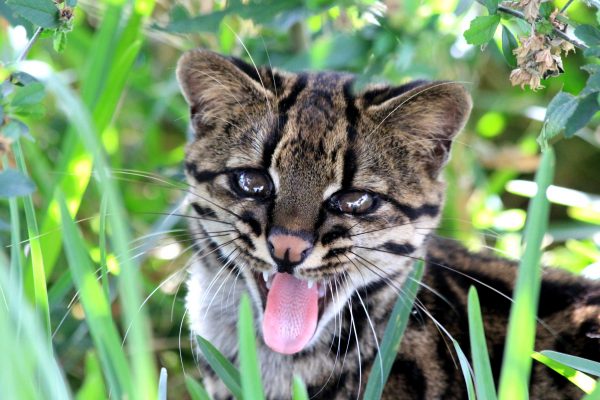-
Sloth Journals | Part II
Bilbo, Male 2-Fingered Sloth “Don’t worry, man, everything’s cool.” Age: ~ One year and two months (probably a few…
Continue reading -
Sloth Journals | Part II
Gimli, Male Two-Fingered Sloth “Come here and say that to my face!” Age: ~ One year and one month Current Weight: 3 kg
Continue reading -
-
Australian looking for “Pura Vida”
My name is Georgie and I come from the Wollongong region of Australia. For all the non-Aussies out there, that’s Wool-on-gong, a Wodi-Wodi Aboriginal word referring to the city’s…
Continue reading -
From Across the Pond & Into the Jungle
So, my name is Alice, I’m your average 26-year-old British girl. I’ve been working with animals for half a decade as a zoo presenter, zookeeper, and more recently (for…
Continue reading -
Tabu the Endangered Oncilla
The Oncilla (Leopardus tigrinus) sometimes referred to as a tiger cat, is one of the smallest felid species in the Americas. Their coat is typically a light brown colour with dark brown/black splotches as such they are often mistaken for Margays or Ocelot although they are considerably smaller weighing on average 1.5 to 3 kg. Oncillas live nocturnal lives in thick vegetation, making them difficult to find and thus little is known about their lives. They are good climbers however they typically hunt ground-dwelling prey, mostly small rodents but also lizards, birds and invertebrates. Studies have shown that in areas with a higher concentration of larger cats eg. Ocelots and Pumas the Oncillas became more active during the daytime, possibly to minimise competition. Oncillas are considered vulnerable by the IUCN with threats including poaching for its fur and deforestation for coffee plantations, cattle ranching and agriculture. In the wild Oncillas have a lifespan of about 11 years, however they have been know to survive up to 20 years in captivity. Oncillas are rarely found in captivity with only 2 individuals, both male, in captivity Costa Rica. Tabu is thought to have originally been kept as a pet, however he is now able to relax in the sun and practise his stalking skills as a resident at the Toucan Rescue Ranch. By former intern Katie Grant
Continue reading -
A Fiery-Billed & Collared Aracari
In my opinion, working at the Ranch is a big responsibility and also a big pleasure. Seeing an animal grow stronger each passing day and recuperate from a bad situation is definitely a calling. This is what happened with two of our residents, the collared aracari and the fiery billed aracari. The collared aracari that joined us in February, had just escaped from being kept as a pet. His situation was evident. His back feathers were a dull gray compared to the iridescent black of a wild specimen. His chest was a pale white instead of the almost neon yellow characteristic to his species, and his beak was discolored as if drained of life. He started recuperating almost immediately. The protein we provided in his new diet and the attention he received started slowly turning his plumage brighter and brighter, until the day came when he finally was allowed outside the clinic and into a big enclosure with his own species. The transition process didn't go so well though. The other collared aracaris weren't so keen on accepting our little friend, so he was sent back to the clinic. That changed when we saw him interacting with another fiery-billed aracari who was also in the clinic. Hopeful plans were made as we put both aracaris into an enclosure of their own. Happily, they’ve accepted each other and now share this wonderful living space together at TRR. By former volunteer Andres Saenz Brautigam
Continue reading -
Izzy Makes a New Friend
It's difficult to not fear monkeys after being chased down by a group of macaque monkeys at the tender age of seven and, then again at the age of 20, being trapped in a bathroom by a large male patiently waiting for me outside the door. Needless to say, I've been traumatized by monkeys and held a fear for them my whole life. So you can imagine the day I arrived at the Toucan Rescue Ranch to see adult spider monkeys. I was quite surprised and very nervous. A few weeks went by and I plucked up the courage to begin helping with the spider monkeys morning and afternoon feeding. If I got a little too close, both Izzy and Noelia would reach through and grab chunks of my hair, taking my dignity with it. I was determined at this stage to conquer my fear and decided I would slowly work towards gaining their trust. In the afternoons, I would take them treats and after a period of time they started to warm up to me- Izzy in particular. I am now at the point where Izzy will anticipate my arrival at the enclosure and she will come down to greet me, following me as I manage their feeding and care. I've learnt that spider monkeys are very intelligent and can sense fear in people. As my fear disappeared the bond between us grew and I'm very grateful for having had this special time with her here at the Ranch. You can ADOPT Izzy or animals like her by visiting our ADOPTION page! By former volunteer Talia Harris | Read more about volunteer's experiences by subscribing to our newsletter!
Continue reading -
A Day in Rocky’s Quills
Hola my spiky amigos, My name is Rocky and the humans tell me that I am a baby Porcupine, whatever that is. All I know is that I am small and spiky and I love nibbling on corn. I´m not sure how I got here, but thank God I did. I remember being a very happy baby Porcupine. My mummy and I were living in a place full of little humans. I think you call it a school. I liked living there. I would listen to the tiny people playing and laughing while I cuddled with my mummy. But one day, the humans were much too close and much too loud. They were all around me and I was scared. Where was my mummy? I don’t know what happened. Maybe I fell? I can’t remember but I was all alone, surrounded by humans and my mummy was gone. I was so afraid. I cried. I used to cry a lot when I first lost my mummy. Luckily, a nice man who wasn't afraid of my spikes, bundled me up and brought me to this safe place. When I arrived I remember hearing the most loving sound- my new human mummy´s voice. Her name was Leslie. Leslie gave me lots of love and care and made me feel safe again. There are other people here that care for me too and they come and visit me every day. They bring me food and they talk to me. One human in particular loves to spend time with me. She comes almost every day and she talks to me and feeds me corn. She´s not afraid of my spikes either. She encourages me to sit up like a big boy and hold the corn myself to eat it, I drop it a lot but she always picks it up and hands it back to me. The only thing is, she talks funny- not like the rest of the humans, I´ve heard people say she is all the way from England so maybe that´s why. But it´s ok because I know she loves me. For a while I’ve been living in my own cage but I know there are other, bigger porcupines around me. I can hear them. A few days ago my cage was opened and now I get to roam around with my bigger amigos. I must admit, when I was feeling brave, I would sometimes make a run for it when the humans brought me my food. My escape never lasted long before the humans returned me to my safe cage. At first I was afraid to leave my cage, but one night I decided I had to be a brave boy and climbed all the way to the top of my new big house where the big Porcupines live. Their names are Merry and Pokey. Pokey sleeps all the time but Merry reminds me of my mummy. I think she will take care of me. The humans tell me that one day when I am big enough and strong enough, I will be released back into the wild. That´s very exciting! But for now, I am very happy in my home with all of these humans that love me. I am safe and I am very lucky my human mummy Leslie found me. I hope you enjoyed my story but now I must go, I see my humans coming with corn. Until next time my spiky amigos. You can adopt animals like Rocky by supporting our Adoption Program! By former volunteer Robyn Shimwell | You can read more articles like this one on our newsletter, subscribe today!
Continue reading -
A Grey Hawk’s Journey
A Grey Hawk's Journey When I came to the Ranch in July, there was a particularly special animal that immediately stole my heart. It was a grey hawk that was brought to us as a juvenile. His wings had been clipped. Someone tried to keep this incredible raptor as a pet and robbed him of the opportunity to grow in the wild. When he first arrived we placed him in a smaller enclosure while waiting for our soft-release enclosure to become available. When we noticed that he was displaying all the signs of progression, we knew he was a release candidate! He was hunting, mantling over his food and calling to other birds in the sky. When we moved him to our pre-release enclosure, it was a very special day. Without hesitation, he flew to the back of the enclosure and perched on the highest beam. There were days that I would check on him to find that he had captured his own live prey, prey that I hadn't introduced to his enclosure. His amazing hunting abilities even gained him the nickname of "Killer" amongst a few of the volunteers at TRR. Watching his progression and aiding in his rehabilitation has been one of the most rewarding and gratifying experiences I've had since coming to Costa Rica. He was released on March 25, 2017 in Cartago, Costa Rica! You can watch the hawk's release on our YouTube channel! By Intern Mackenzie King | You can read updates like this one by subscribing to our monthly newsletter!
Continue reading











